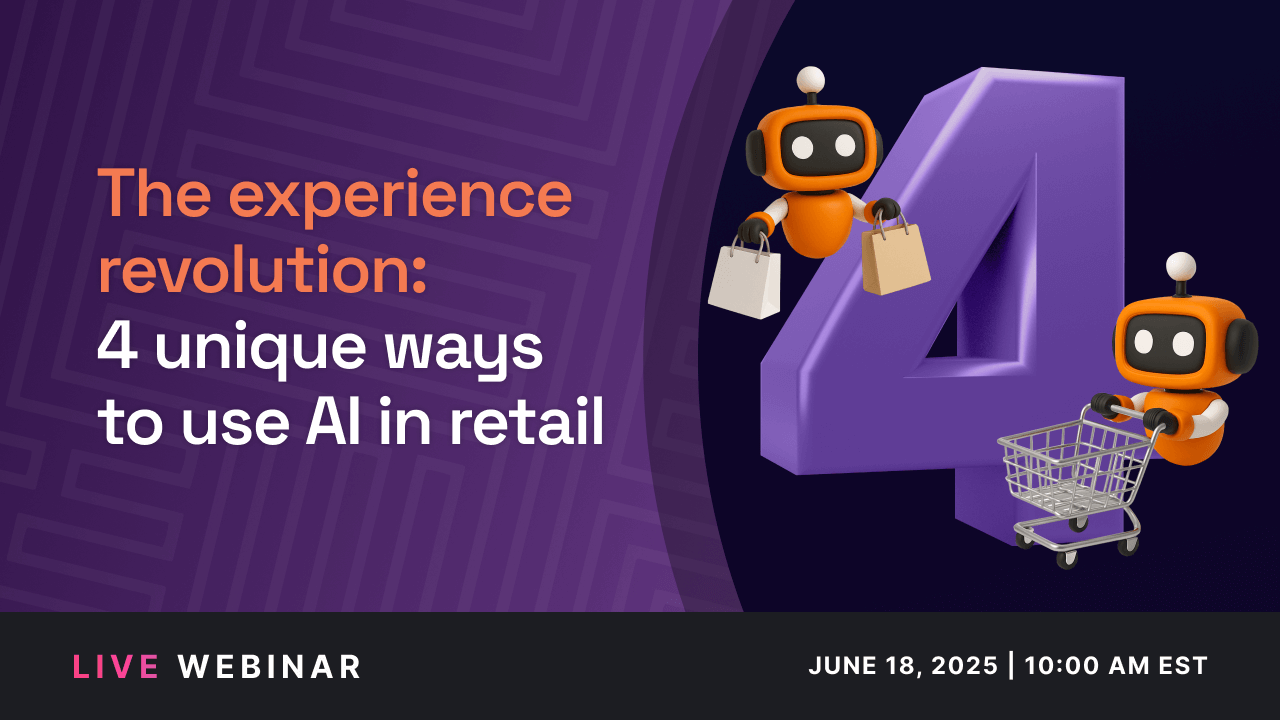article
Retail digital transformation in 2025
How to build connected experiences that drive real ROI
June 10, 2025 • 6 minutes

The retail industry just crossed a historic threshold. The 2024 holiday season marked the first time online transactions exceeded in-store purchases — yet physical retail still accounts for over 80% of transactions. If that sounds contradictory, you’re beginning to understand why retail digital transformation in 2025 is more complex than simply “going digital.”
The reality is that successful retailers are no longer thinking in terms of online versus offline. They’re building unified experiences that recognize how customers actually behave: researching online, exploring in-store, checking out on mobile apps, and expecting seamless engagement with the retailer throughout.
Here’s what makes this particularly challenging: While you’re figuring out this new landscape, your customers and employees are already there. Over 90% of shoppers use mobile devices while shopping in physical stores, and despite Gen-Zs being digital natives, up to 58% of them actually prefer in-store shopping experiences over online.
The disconnect between customer behavior and retail operations and/or capabilities has created an experience gap that’s becoming a competitive chasm. The retailers who close it first will own their markets.
Why traditional approaches are failing
Most retailers are still applying yesterday’s thinking to today’s challenges. They’re bolting digital technologies onto existing processes instead of reimagining the entire experience model. The result? More complexity, not less — and definitely not the seamless experiences customers now expect.
The problem isn’t technology. It’s that legacy systems were built for transactions, not relationships. Organizational and data silos are optimized for departmental metrics rather than customer outcomes. And the scale challenge means that even small inefficiencies multiply across thousands of locations and millions of customer interactions.
Consider this: When different departments — e-commerce, store operations, marketing, merchandising, customer service, inventory management — each optimize for their own metrics, customers encounter jarring inconsistencies across touchpoints. E-commerce celebrates a conversion while the store gets penalized if the customer returns to them. One team may look to generate clicks while another drives footfall. But what does all that mean for the retailer holistically?
The 3 dimensions of retail digital transformation that actually work
Our research across retail segments reveals that successful digital transformation focuses on three interconnected dimensions. Get all three right, and you create sustainable competitive advantage.
1. Customer experience: Building relationships, not just processing transactions
The shift from transactional to relationship-based business models isn’t just about customer satisfaction — it’s about financial performance. Personalized shopping experiences can increase basket size by up to 40%, but only when retailers move beyond simple product recommendations to comprehensive experience personalization.
This means unifying customer data across all touchpoints so customers receive consistent recognition and service whether they’re online, in-store, or using mobile apps. It means engaging proactively with refill reminders, personalized marketing promotions, and post-purchase support…without being invasive. And critically, it means recognizing that 90% of shoppers are using their phones while in-store and meeting them in that moment of decision to shape their journey.
Luxury brands implementing conversational AI in retail have reported over 100% increases in online sales and increased NPS by strengthening both digital and human customer engagement. The key insight: Customers move fluidly between channels, so your experience and digital transformation strategy must seamlessly do the same.
2. Associate experience: An undervalued competitive asset
While this has been known for a long time, the landscape post-Covid has highlighted the criticality of our staff, and that associate experience directly impacts customer experience. With persistent staffing shortages and rising expectations from Gen-Z employees, workforce transformation isn’t optional — it’s strategic.
The financial impact is measurable. One retailer that overhauled its associate experience saw a 50% reduction in turnover and 60% decrease in hiring costs. But the benefits extend beyond cost savings. Engaged associates are less likely to move to a competitor or leave the industry, and they create better customer experiences, which in turn drives customer loyalty and retention.
This transformation requires digitizing traditionally paper-based business processes — scheduling, onboarding, training — so associates can self-manage from their devices. It means providing real-time support tools using AI and guided workflows so they can answer questions confidently. And it means reducing friction in administrative tasks so they can focus on customer-facing work.
3. Business partner collaboration: Breaking down the silos
The third dimension — often completely overlooked — involves the ecosystem of business partners. From franchisees to suppliers to logistics providers, these supply chain relationships directly impact your ability to deliver seamless retail experiences.
Yet many retailers still manage these relationships through siloed systems and manual communication. The opportunity is enormous: When partners are empowered with unified engagement platforms and real-time data analytics, retailers become more agile, respond faster to disruptions, and improve visibility.
This isn’t just about operational efficiency. It’s about competitive advantage. When your entire ecosystem operates as an integrated unit, you can deliver experiences that competitors with fragmented partner relationships simply cannot match.
The ROI of getting it right
When retailers implement connected experiences across all three dimensions, the results are measurable:
- One luxury retail business increased online sales by 120% through conversational AI-powered shopping.
- A specialty retailer improved agent productivity by 20% by shifting from phone calls to messaging.
- A specialty retailer reduced hiring costs 60% through improved digital engagement with associates
These aren’t isolated improvements — they’re the compound effect of transformation and AI solutions for retail that addresses the entire ecosystem.
Where to start without getting overwhelmed
Digital transformation in retail doesn’t require a complete systems overhaul on day one. The most successful retailers begin with high-impact, low-friction use cases that demonstrate value quickly while building toward more comprehensive change over time — consumable, quantifiable bite-sized pieces toward a larger strategy.
Consider starting with mobile scheduling for employees or improving digital in-aisle engagement for customers. These initiatives can deliver immediate benefits while creating the foundation for unified data, AI-powered personalization, and integrated partner ecosystems.
The critical factor is change management. Technology is only as effective as the people who use it and the processes that support it. Align leadership, engage stakeholders, and measure progress continuously. Remember: Retail digital transformation is about people and processes working together to achieve a desired business outcome, not just technology deployment.
The competitive reality
Retail in 2025 rewards brands that think holistically about experience transformation. The companies that will dominate their markets are those reimagining customer journeys, empowering their workforce with digital tools, and integrating their partner ecosystems into unified experience strategies.
Retail digital transformation is no longer a future initiative — it’s the foundation for relevance and growth in today’s dynamic market. The question isn’t whether to transform, but how quickly you can build the connected experiences that will define competitive advantage.
The retailers who understand this are already building sustainable advantages through stronger relationships, more efficient operations, and the agility to adapt to whatever changes come next. The rest are about to discover how quickly retail markets can shift.
Ready to dive deeper?
Join Mark in a webinar on June 18 to explore how innovative retailers are using AI to reshape the future of shopping and work.


